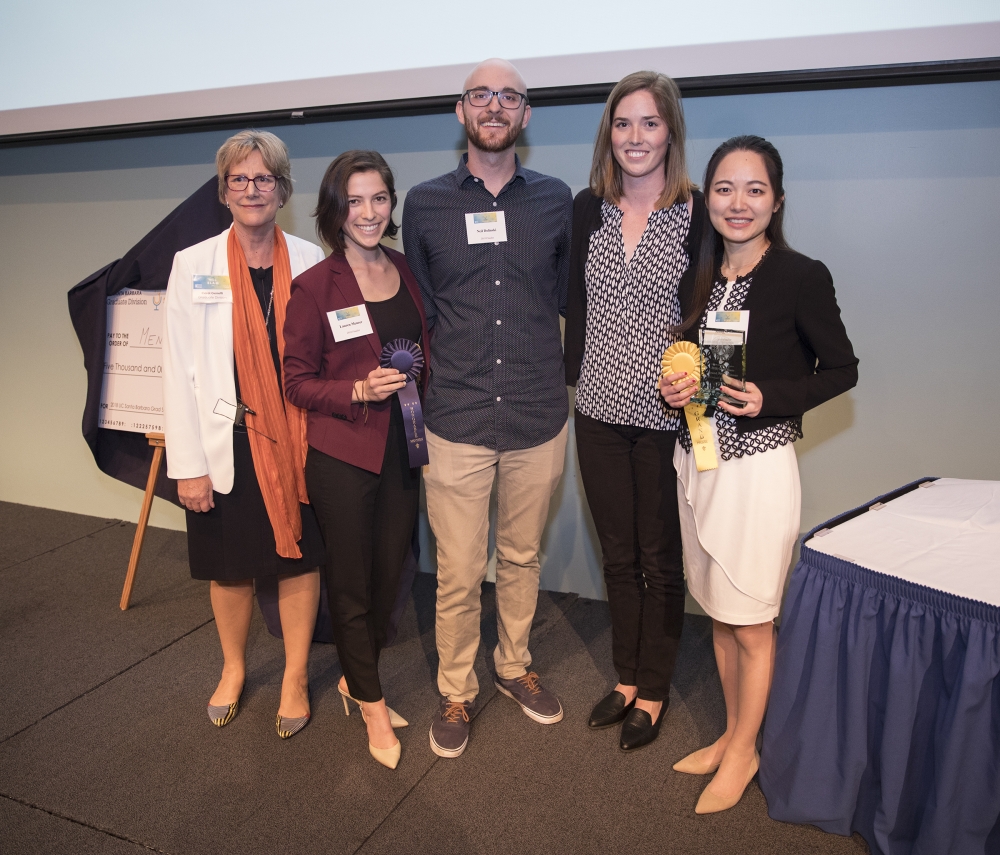In Three Minutes or Less

Getting into graduate school can be very competitive, but once there, the students find the competition can be, well, downright fun — at least for those who participate in UC Santa Barbara’s Grad Slam.
This year, it was especially so for Mengya Tao of the Bren School of Environmental Science & Management. For her presentation of a chemical risk assessment tool, she took top honors — and the $5,000 prize — at the sixth annual Grad Slam contest.
More than 50 graduate students honed explanations of their research into easily understandable, and relatable, material. Judged on how well they engage the audience, how clearly they communicate key concepts and how effectively they focus and present their ideas, participants must accomplish it all in three minutes or less.
The nine finalists in the two-week tournament each had a one-in-three chance of finishing in the top three, but all were guaranteed to receive at least $750 for their participation. Runners-up Neil Dolinski and Lauren Menzer each won $2,500 for their respective presentations on 3-D printing and on toxins in the apparel supply chain.
“We had a very tough competition this year with many students producing remarkable talks,” said Carol Genetti, UCSB’s Anne and Michael Towbes Graduate Dean. “Those in the final round were truly exceptional. Grad Slam is a great opportunity to appreciate not only our graduate students but the whole UCSB campus and what we produce.”
Inaugurated at UC Santa Barbara in 2013, Grad Slam was adopted by the other University of California campuses. Now, the winners square off against one another in the UC-wide Grad Slam competition hosted by UC President Janet Napolitano. On May 3, Tao will represent UC Santa Barbara at the UC contest at LinkedIn headquarters in downtown San Francisco, hoping to capture the systemwide title and her share of $10,000 in prize money.
Last year’s UCSB winner Leah Foltz won the first-ever UC-wide audience choice award, which is determined by viewers’ online votes for their favorite presenter. This year’s contest will be live-streamedstarting at 11:30 a.m.
New winner Tao said she is grateful for the opportunity to present her research to the general public. In her presentation, “A Safer World with Fewer Regrettable Chemicals,” she explained that she wants to understand the environmental and human health impact of chemicals more efficiently.
“It’s like a dream,” Tao said following her victory. “I still can’t believe I won. I’m very proud to represent UCSB at the UC-wide competition. Meeting with students from other campuses is a great opportunity.”
Runner-up Dolinski, a graduate student in the materials department, is helping to improve 3-D printing. He and his colleagues are using colored visible light to produce both stretchy, pliable materials and those that are structurally stiff. What’s more, their method does so at speeds 50 to 200 times faster than traditional 3-D printing.
Runner-up Menzer, also from the Bren School, tracked endocrine disrupting chemicals — flame retardants, chlorine bleach, formaldehyde and ammonia — through the apparel supply chain. These toxins end up in clothing and interfere with the human hormone system, causing obesity and infertility and affecting mood and metabolism.
Additional 2018 UCSB Grad Slam finalists are Rebecca Baker (English); May ElSherif (computer science); Andrea Figueroa-Caballero (communication); Katie Harrison (communication); Veronica Laos (chemistry); and Erin Winslow (environmental science and management).
The finals judges’ panel included UCSB’s Executive Vice Chancellor David Marshall; Vice Chancellor for Student Affairs Margaret Klawunn; UCSB Librarian Kristin Antelman; and Associate Vice Chancellor for Public Affairs and Communications John Longbrake.
More than $15,000 in cash and prizes were awarded, thanks to this year’s corporate sponsors: QAD Inc.; Yardi Systems Inc.; Corning Inc.; FLIR Systems Inc.; HRL Laboratories, LLC; and Northrop Grumman Corp.



